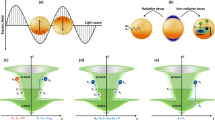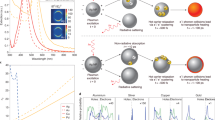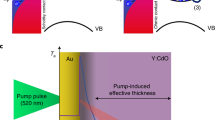Abstract
Finding higher efficiency schemes for electron–hole separation is of paramount importance for realizing more efficient conversion of solar energy in photovoltaic and photocatalytic devices. Plasmonic energy conversion has been proposed as a promising alternative to conventional electron–hole separation in semiconductor devices. This emerging method is based on the generation of hot electrons in plasmonic nanostructures through electromagnetic decay of surface plasmons. Here, the fundamentals of hot-electron generation, injection and regeneration are reviewed, with special attention paid to recent progress towards photovoltaic devices. This new energy-conversion method potentially offers high conversion efficiencies, while keeping fabrication costs low. However, several considerations regarding the materials, architectures and fabrication methods used need to be carefully evaluated to advance this field.
This is a preview of subscription content, access via your institution
Access options
Subscribe to this journal
Receive 12 print issues and online access
$209.00 per year
only $17.42 per issue
Buy this article
- Purchase on Springer Link
- Instant access to full article PDF
Prices may be subject to local taxes which are calculated during checkout




Similar content being viewed by others
References
Atwater, H. A. The promise of plasmonics. Sci. Am. 296, 56–62 (2007).
Mendes, M. J., Luque, A., Tobías, I. & Martí, A. Plasmonic light enhancement in the near-field of metallic nanospheroids for application in intermediate band solar cells. Appl. Phys. Lett. 95, 071105 (2009).
Atwater, H. A. & Polman, A. Plasmonics for improved photovoltaic devices. Nature Mater. 9, 205–213 (2010).
Zhao, G., Kozuka, H. & Yoko, T. Sol—gel preparation and photoelectrochemical properties of TiO2 films containing Au and Ag metal particles. Thin Solid Films 277, 147–154 (1996).
Tian, Y. & Tatsuma, T. Plasmon-induced photoelectrochemistry at metal nanoparticles supported on nanoporous TiO2 . Chem. Commun. 1810–1811 (2004).
Tian, Y. & Tatsuma, T. Mechanisms and applications of plasmon-induced charge separation at TiO2 films loaded with gold nanoparticles. J. Am. Chem. Soc. 127, 7632–7637 (2005).
Knight, M. W., Sobhani, H., Nordlander, P. & Halas, N. J. Photodetection with active optical antennas. Science 332, 702–704 (2011).
Wang, F. & Melosh, N. A. Plasmonic energy collection through hot carrier extraction. Nano Lett. 11, 5426–5430 (2011).
Linic, S., Christopher, P. & Ingram, D. B. Plasmonic-metal nanostructures for efficient conversion of solar to chemical energy. Nature Mater. 10, 911–921 (2011).
Nishijima, Y. et al. Near-infrared plasmon-assisted water oxidation. J. Phys. Chem. Lett. 3, 1248–1252 (2012).
Du, L., Furube, A., Hara, K., Katoh, R. & Tachiya, M. Ultrafast plasmon induced electron injection mechanism in gold–TiO2 nanoparticle system. J. Photochem. Photobiol. C 15, 21–30 (2013).
Knight, M. W. et al. Embedding plasmonic nanostructure diodes enhances hot electron emission. Nano Lett. 13, 1687–1692 (2013).
Mubeen, S. et al. An autonomous photosynthetic device in which all charge carriers derive from surface plasmons. Nature Nanotechnol. 8, 247–251 (2013).
Semenov, A. D., Gol'tsman, G. N. & Sobolewski, R. Hot-electron effect in superconductors and its applications for radiation sensors. Supercond. Sci. Technol. 15, R1 (2002).
Hertz, H. Ueber einen Einfluss des ultravioletten Lichtes auf die electrische Entladung. Ann. Phys. 267, 983–1000 (1887).
Gadzuk, J. W. On the detection of chemically-induced hot electrons in surface processes: from X-ray edges to Schottky barriers. J. Phys. Chem. B 106, 8265–8270 (2002).
Nienhaus, H. Electronic excitations by chemical reactions on metal surfaces. Surf. Sci. Rep. 45, 1–78 (2002).
O'Regan, B. & Grätzel, M. A low-cost, high-efficiency solar cell based on dye-sensitized colloidal TiO2 films. Nature 353, 737–740 (1991).
Grätzel, M. Photoelectrochemical cells. Nature 414, 338–344 (2001).
Sönnichsen, C. et al. Drastic reduction of plasmon damping in gold nanorods. Phys. Rev. Lett. 88, 077402 (2002).
Hofmann, J. & Steinmann, W. Plasma resonance in the photoemission of silver. Phys. Status Solidi B 30, K53–K56 (1968).
Endriz, J. G. & Spicer, W. E. Surface-plasmon-one-electron decay and its observation in photoemission. Phys. Rev. Lett. 24, 64–68 (1970).
Lehmann, J. et al. Surface plasmon dynamics in silver nanoparticles studied by femtosecond time-resolved photoemission. Phys. Rev. Lett. 85, 2921–2924 (2000).
Inagaki, T., Kagami, K. & Arakawa, E. T. Photoacoustic observation of nonradiative decay of surface plasmons in silver. Phys. Rev. B 24, 3644–3646 (1981).
White, T. P. & Catchpole, K. R. Plasmon-enhanced internal photoemission for photovoltaics: theoretical efficiency limits. Appl. Phys. Lett. 101, 073905 (2012).
Berglund, C. N. & Spicer, W. E. Photoemission studies of copper and silver: experiment. Phys. Rev. 136, A1044–A1064 (1964).
Rycenga, M. et al. Controlling the synthesis and assembly of silver nanostructures for plasmonic applications. Chem. Rev. 111, 3669–3712 (2011).
Moskovits, M. Hot electrons cross boundaries. Science 332, 676–677 (2011).
Nishijima, Y., Ueno, K., Yokota, Y., Murakoshi, K. & Misawa, H. Plasmon-assisted photocurrent generation from visible to near-infrared wavelength using a Au-nanorods/TiO2 electrode. J. Phys. Chem. Lett. 1, 2031–2036 (2010).
Ohko, Y. et al. Multicolour photochromism of TiO2 films loaded with silver nanoparticles. Nature Mater. 2, 29–31 (2003).
Naoi, K., Ohko, Y. & Tatsuma, T. TiO2 films loaded with silver nanoparticles: control of multicolor photochromic behavior. J. Am. Chem. Soc. 126, 3664–3668 (2004).
Hirakawa, T. & Kamat, P. V. Photoinduced electron storage and surface plasmon modulation in Ag@TiO2 clusters. Langmuir 20, 5645–5647 (2004).
Lana-Villarreal, T. & Gómez, R. Tuning the photoelectrochemistry of nanoporous anatase electrodes by modification with gold nanoparticles: development of cathodic photocurrents. Chem. Phys. Lett. 414, 489–494 (2005).
Yu, K., Tian, Y. & Tatsuma, T. Size effects of gold nanaoparticles on plasmon-induced photocurrents of gold–TiO2 nanocomposites. Phys. Chem. Chem. Phys. 8, 5417–5420 (2006).
Sakai, N., Fujiwara, Y., Takahashi, Y. & Tatsuma, T. Plasmon-resonance-based generation of cathodic photocurrent at electrodeposited gold nanoparticles coated with TiO2 films. ChemPhysChem 10, 766–769 (2009).
Kowalska, E., Abe, R. & Ohtani, B. Visible light-induced photocatalytic reaction of gold-modified titanium(IV) oxide particles: action spectrum analysis. Chem. Commun. 241–243 (2009).
Toyoda, T., Tsugawa, S. & Shen, Q. Photoacoustic spectra of Au quantum dots adsorbed on nanostructured TiO2 electrodes together with the photoelectrochemical current characteristics. J. Appl. Phys. 105, 034314 (2009).
Gomes Silva, C., Juárez, R., Marino, T., Molinari, R. & García, H. Influence of excitation wavelength (UV or visible light) on the photocatalytic activity of titania containing gold nanoparticles for the generation of hydrogen or oxygen from water. J. Am. Chem. Soc. 133, 595–602 (2010).
Kowalska, E., Mahaney, O. O. P., Abe, R. & Ohtani, B. Visible-light-induced photocatalysis through surface plasmon excitation of gold on titania surfaces. Phys. Chem. Chem. Phys. 12, 2344–2355 (2010).
Ide, Y., Matsuoka, M. & Ogawa, M. Efficient visible-light-induced photocatalytic activity on gold-nanoparticle-supported layered titanate. J. Am. Chem. Soc. 132, 16762–16764 (2010).
Valverde-Aguilar, G., García-Macedo, J. A., Rentería-Tapia, V. & Aguilar-Franco, M. Photoconductivity studies on amorphous and crystalline TiO2 films doped with gold nanoparticles. Appl. Phys. A 103, 659–663 (2011).
Ingram, D. B., Christopher, P., Bauer, J. L. & Linic, S. Predictive model for the design of plasmonic metal/semiconductor composite photocatalysts. ACS Catal. 1, 1441–1447 (2011).
Tanaka, A. et al. Gold–titanium(IV) oxide plasmonic photocatalysts prepared by a colloid-photodeposition method: correlation between physical properties and photocatalytic activities. Langmuir 28, 13105–13111 (2012).
Shi, X., Ueno, K., Takabayashi, N. & Misawa, H. Plasmon-enhanced photocurrent generation and water oxidation with a gold nanoisland-loaded titanium dioxide photoelectrode. J. Phys. Chem. C 117, 2494–2499 (2013).
Gong, D. et al. Silver decorated titanate/titania nanostructures for efficient solar driven photocatalysis. J. Solid State Chem. 189, 117–122 (2012).
Sakai, N., Sasaki, T., Matsubara, K. & Tatsuma, T. Layer-by-layer assembly of gold nanoparticles with titania nanosheets: control of plasmon resonance and photovoltaic properties. J. Mater. Chem. 20, 4371–4378 (2010).
Shiraishi, Y. et al. Platinum nanoparticles supported on anatase titanium dioxide as highly active catalysts for aerobic oxidation under visible light irradiation. ACS Catal. 2, 1984–1992 (2012).
Wu, F. et al. Photocatalytic activity of Ag/TiO2 nanotube arrays enhanced by surface plasmon resonance and application in hydrogen evolution by water splitting. Plasmonics 8, 501–508 (2012).
Chen, K. et al. Effect of Ag nanoparticle size on the photoelectrochemical properties of Ag decorated TiO2 nanotube arrays. J. Alloys Compd 554, 72–79 (2013).
Chen, Z. H. et al. Vertically aligned ZnO nanorod arrays sentisized with gold nanoparticles for Schottky barrier photovoltaic cells. J. Phys. Chem. C 113, 13433–13437 (2009).
Chen, H. M. et al. Plasmon inducing effects for enhanced photoelectrochemical water splitting: X-ray absorption approach to electronic structures. ACS Nano 6, 7362–7372 (2012).
Han, Z. et al. Visible-light photocatalytic application of hierarchical Au-ZnO flower-rod heterostructures via surface plasmon resonance. Plasmonics 8, 1193–1202 (2013).
Primo, A., Marino, T., Corma, A., Molinari, R. & García, H. Efficient visible-light photocatalytic water splitting by minute amounts of gold supported on nanoparticulate CeO2 obtained by a biopolymer templating method. J. Am. Chem. Soc. 133, 6930–6933 (2011).
Kominami, H., Tanaka, A. & Hashimoto, K. Mineralization of organic acids in aqueous suspensions of gold nanoparticles supported on cerium(IV) oxide powder under visible light irradiation. Chem. Commun. 46, 1287–1289 (2010).
Chen, X., Li, P., Tong, H., Kako, T. & Ye, J. Nanoarchitectonics of a Au nanoprism array on WO3 film for synergistic optoelectronic response. Sci. Technol. Adv. Mater. 12, 044604 (2011).
Zhou, X., Hu, C., Hu, X., Peng, T. & Qu, J. Plasmon-assisted degradation of toxic pollutants with Ag−AgBr/Al2O3 under visible-light irradiation. J. Phys. Chem. C 114, 2746–2750 (2010).
Hu, C. et al. Plasmon-induced photodegradation of toxic pollutants with Ag−AgI/Al2O3 under visible-light irradiation. J. Am. Chem. Soc. 132, 857–862 (2009).
Wang, P. et al. Ag@AgCl: a highly efficient and stable photocatalyst active under visible light. Angew. Chem. 47, 7931–7933 (2008).
Kochuveedu, S. T., Kim, D.-P. & Kim, D. H. Surface-plasmon-induced visible light photocatalytic activity of TiO2 nanospheres decorated by Au nanoparticles with controlled configuration. J. Phys. Chem. C 116, 2500–2506 (2012).
Zhang, N., Liu, S., Fu, X. & Xu, Y.-J. Synthesis of M@TiO2 (M = Au, Pd, Pt) core-shell nanocomposites with tunable photoreactivity. J. Phys. Chem. C 115, 9136–9145 (2011).
Zheng, Z. et al. Facile in situ synthesis of visible-light plasmonic photocatalysts M@TiO2 (M = Au, Pt, Ag) and evaluation of their photocatalytic oxidation of benzene to phenol. J. Mater. Chem. 21, 9079–9087 (2011).
Furube, A., Du, L., Hara, K., Katoh, R. & Tachiya, M. Ultrafast plasmon-induced electron transfer from gold nanodots into TiO2 nanoparticles. J. Am. Chem. Soc. 129, 14852–14853 (2007).
Tian, Y., Wang, X., Zhang, D., Shi, X. & Wang, S. Effects of electron donors on the performance of plasmon-induced photovoltaic cell. J. Photochem. Photobiol., A 199, 224–229 (2008).
Tian, Y., Shi, X., Lu, C., Wang, X. & Wang, S. Charge separation in solid-state gold nanoparticles-sensitized photovoltaic cell. Electrochem. Commun. 11, 1603–1605 (2009).
Du, L. et al. Plasmon-induced charge separation and recombination dynamics in gold−TiO2 nanoparticle systems: dependence on TiO2 particle size. J. Phys. Chem. C 113, 6454–6462 (2009).
Inouye, H., Tanaka, K., Tanahashi, I. & Hirao, K. Ultrafast dynamics of nonequilibrium electrons in a gold nanoparticle system. Phys. Rev. B 57, 11334–11340 (1998).
Kreibig, U. & Vollmer, M. Optical Properties of Metal Clusters. (Springer, 1995).
Langhammer, C., Yuan, Z., Zorić, I. & Kasemo, B. Plasmonic properties of supported Pt and Pd nanostructures. Nano Lett. 6, 833–838 (2006).
Skoplaki, E. & Palyvos, J. A. On the temperature dependence of photovoltaic module electrical performance: a review of efficiency/power correlations. Sol. Energy 83, 614–624 (2009).
Kazuma, E., Sakai, N. & Tatsuma, T. Nanoimaging of localized plasmon-induced charge separation. Chem. Commun. 47, 5777–5779 (2011).
Kazuma, E. & Tatsuma, T. Photoelectrochemical analysis of allowed and forbidden multipole plasmon modes of polydisperse Ag nanorods. J. Phys. Chem. C 117, 2435–3441 (2013).
Yu, K., Sakai, N. & Tatsuma, T. Plasmon resonance-based solid-state photovoltaic devices. Electrochem. Commun. 76, 161 (2008).
Takahashi, Y. & Tatsuma, T. Electrodeposition of thermally stable gold and silver nanoparticle ensembles through a thin alumina nanomask. Nanoscale 2, 1494–1499 (2010).
Takahashi, Y. & Tatsuma, T. Solid state photovoltaic cells based on localized surface plasmon-induced charge separation. Appl. Phys. Lett. 99, 182110–182113 (2011).
Reineck, P. et al. A solid-state plasmonic solar cell via metal nanoparticle self-assembly. Adv. Mater. 24, 4750–4755 (2012).
Nakanishi, H. et al. Photoconductance and inverse photoconductance in films of functionalized metal nanoparticles. Nature 460, 371–375 (2009).
Warren, S. C., Walker, D. A. & Grzybowski, B. A. Plasmoelectronics: coupling plasmonic excitation with electron flow. Langmuir 28, 9093–9102 (2012).
Mubeen, S., Hernandez-Sosa, G., Moses, D., Lee, J. & Moskovits, M. Plasmonic photosensitization of a wide band gap semiconductor: converting plasmons to charge carriers. Nano Lett. 11, 5548–5552 (2011).
Son, M.-S. et al. Surface plasmon enhanced photoconductance and single electron effects in mesoporous titania nanofibers loaded with gold nanoparticles. Appl. Phys. Lett. 96, 023115 (2010).
Lee, Y. K. et al. Surface plasmon-driven hot electron flow probed with metal-semiconductor nanodiodes. Nano Lett. 11, 4251–4255 (2011).
Lee, Y. K., Park, J. & Park, J. Y. The effect of dye molecules and surface plasmons in photon-induced hot electron flows detected on Au/TiO2 nanodiodes. J. Phys. Chem. C 116, 18591–18596 (2012).
Wadell, C., Antosiewicz, T. J. & Langhammer, C. Optical absorption engineering in stacked plasmonic Au-SiO2-Pd nanoantennas. Nano Lett. 12, 4784–4790 (2012).
Garcia, G. et al. Dynamically modulating the surface plasmon resonance of doped semiconductor nanocrystals. Nano Lett. 11, 4415–4420 (2011).
Pradhan, A. K., Holloway, T., Mundle, R., Dondapati, H. & Bahoura, M. Energy harvesting in semiconductor-insulator-semiconductor junctions through excitation of surface plasmon polaritons. Appl. Phys. Lett. 100, 061127 (2012).
Green, M. A., Emery, K., Hishikawa, Y., Warta, W. & Dunlop, E. D. Solar cell efficiency tables (version 39). Prog. Photovoltaics Res. Appl. 20, 12–20 (2012).
Green, M. A. Third generation photovoltaics: solar cells for 2020 and beyond. Physica E 14, 65–70 (2002).
Mokkapati, S. & Catchpole, K. R. Nanophotonic light trapping in solar cells. J. Appl. Phys. 112, 101101 (2012).
Atar, F. B. et al. Plasmonically enhanced hot electron based photovoltaic device. Opt. Express 21, 7196–7201 (2013).
Binns, C. Nanoclusters deposited on surfaces. Surf. Sci. Rep. 44, 1–49 (2001).
Palmer, R. E., Pratontep, S. & Boyen, H.-G. Nanostructured surfaces from size-selected clusters. Nature Mater. 2, 443–448 (2003).
Wegner, K., Piseri, P., Vahedi-Tafreshi, H. & Milani, P. Cluster beam deposition: a tool for nanoscale science and technology. J. Phys. D 39, R439 (2006).
Perelaer, J. & Schubert, U. S. Novel approaches for low temperature sintering of inkjet-printed inorganic nanoparticles for roll-to-roll (R2R) applications. J. Mater. Res. 28, 564–573 (2013).
Kittel, C. Introduction to Solid State Physics. (Wiley, 1976).
Hövel, H., Fritz, S., Hilger, A., Kreibig, U. & Vollmer, M. Width of cluster plasmon resonances: bulk dielectric functions and chemical interface damping. Phys. Rev. B 48, 18178–18188 (1993).
Mendelsberg, R. J. et al. Achieving high mobility ZnO:Al at very high growth rates by dc filtered cathodic arc deposition. J. Phys. D 44, 232003 (2011).
West, P. R. et al. Searching for better plasmonic materials. Las. Photon. Rev. 4, 795–808 (2010).
Naik, G. V., Kim, J. & Boltasseva, A. Oxides and nitrides as alternative plasmonic materials in the optical range. Opt. Mater. Express 1, 1090–1099 (2011).
Naik, G. V. et al. Titanium nitride as a plasmonic material for visible and near-infrared wavelengths. Opt. Mater. Express 2, 478–489 (2012).
Cushing, S. K. et al. Photocatalytic activity enhanced by plasmonic resonant energy transfer from metal to semiconductor. J. Am. Chem. Soc. 134, 15033–15041 (2012).
Magesh, G., Viswanathan, B., Viswanath, R. P. & Varadarajan, T. K. Photocatalytic behavior of CeO2-TiO2 system for the degradation of methylene blue. Indian J. Chem. A 48, 480–488 (2009).
Taft, E. A., Philipp, H. R. & Apker, L. Photoelectric emission from the valence band in AgBr. Phys. Rev. 110, 876–878 (1958).
Park, Y., Choong, V., Gao, Y., Hsieh, B. R. & Tang, C. W. Work function of indium tin oxide transparent conductor measured by photoelectron spectroscopy. Appl. Phys. Lett. 68, 2699–2701 (1996).
Helander, M. G., Greiner, M. T., Wang, Z. B., Tang, W. M. & Lu, Z. H. Work function of fluorine doped tin oxide. J. Vac. Sci. Technol. A 29, 011019 (2011).
Wang, W. et al. Dependence of aluminum-doped zinc oxide work function on surface cleaning method as studied by ultraviolet and X-ray photoelectron spectroscopies. Appl. Surf. Sci. 257, 3884–3887 (2011).
Yoshida, K., Aoki, T., Suzuki, A., Matsushita, T. & Okuda, M. Work function controlled transparent conductive films with zinc oxide system by pulsed laser deposition method. J. Vac. Soc. Japan 51, 172–174 (2008).
Acknowledgements
The author thanks A. Anders and R. Mendelsberg for insightful discussions. This work was supported by the Assistant Secretary for Energy Efficiency and Renewable Energy, Office of Building Technology, of the US Department of Energy under Contract No. DE-AC02-05CH11231.
Author information
Authors and Affiliations
Corresponding author
Ethics declarations
Competing interests
The author declares no competing financial interests.
Rights and permissions
About this article
Cite this article
Clavero, C. Plasmon-induced hot-electron generation at nanoparticle/metal-oxide interfaces for photovoltaic and photocatalytic devices. Nature Photon 8, 95–103 (2014). https://doi.org/10.1038/nphoton.2013.238
Received:
Accepted:
Published:
Issue Date:
DOI: https://doi.org/10.1038/nphoton.2013.238
This article is cited by
-
Ultra-stable and highly reactive colloidal gold nanoparticle catalysts protected using multi-dentate metal oxide nanoclusters
Nature Communications (2024)
-
All-optical control of high-purity trions in nanoscale waveguide
Nature Communications (2023)
-
Plasmon-mediated chemical reactions
Nature Reviews Methods Primers (2023)
-
Silver nanoparticle enhanced metal-organic matrix with interface-engineering for efficient photocatalytic hydrogen evolution
Nature Communications (2023)
-
Photo-plasmonic effect as the hot electron generation mechanism
Scientific Reports (2023)



